Ramin Djawadi & The Lannister Theme: How GAME OF THRONES Told Stories Through Song
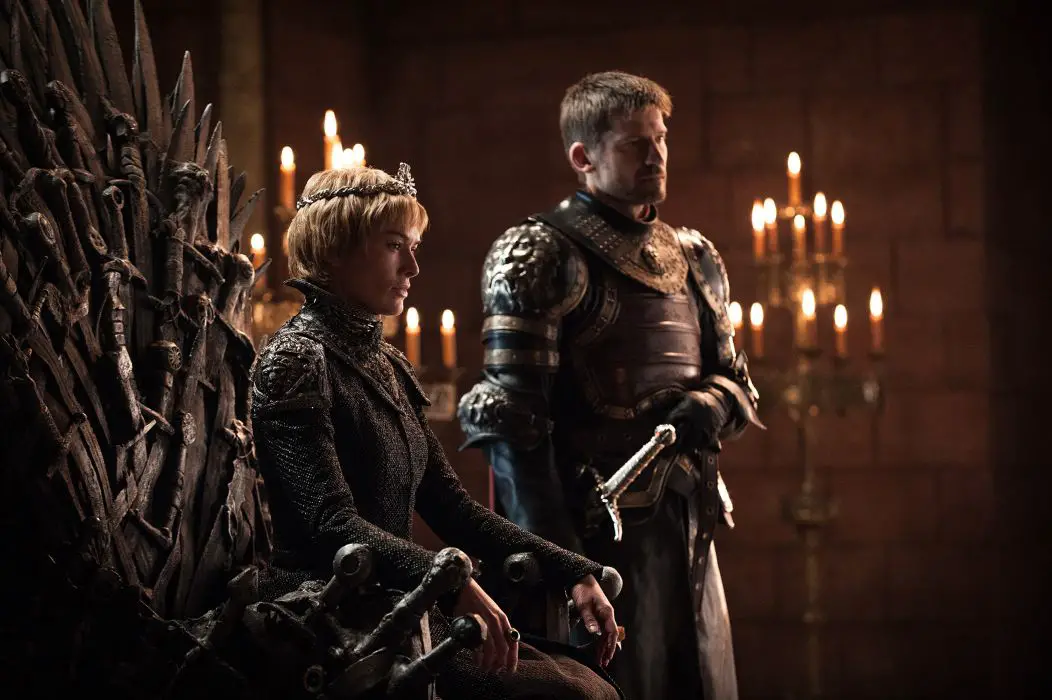
Jo is 21 years old, studying film and theatre at…
Game of Thrones is one of the most successful and influential television series of all time. The HBO program has not only changed the landscape of pop culture, becoming the most illegally streamed show in the world from 2011-2017. But it has also heralded in a new era of prestige cinematic television, as hundreds of shows scramble to imitate the once in a life time sensation that is Game of Thrones. In the nine years since Game of Thrones first premiered, television has shifted from being perceived as a second-rate medium, inferior to television, to being perceived as a medium with huge potential for high quality long-form storytelling. As the expression goes, television has become cinematic, while cinema, with its increasing sway towards sequels and franchises, has become more televisual.
One key element that establishes Game of Thrones as prestige television, is its score, by Grammy-nominated, Emmy-winning composer Ramin Djawadi. One of the many things that makes Djawadi’s score is impressive, is his skillful and constant use of leitmotif. Music Professor Roger Parker from King’s College London delivered a lecture in 2008 where he described the great film composer Max Steiner and his use of leitmotifs in King Kong. Parker defines leitmotifs as “prominent themes that become attached to aspects of the unfolding drama and that then recur, sometimes with significant development, when those aspects recur in the narrative.”
Game of Thrones is a political drama set in a fictional fantasy version of Medieval Europe. In the seven kingdoms of Westeros, there are nine major Houses and countless smaller Houses. Djawadi uses leitmotif in his creation of these House scores, so that these scores can be used again and again, in different narrative and musical contexts. These leitmotifs usually had their inception in 2011’s Season 1, and throughout the series continued to grow and develop until a more mature, and often more powerful, version of these original melodies occurred in 2018’s final season 8.
In Ramin Djawadi’s scores, every House has its own theme, with its own leitmotif, and within that many major characters have separate themes and leitmotifs. Today I will be discussing the Lannisters, a family of villains who rule the Seven Kingdoms of Westeros, and the narrative potential of their family theme song, “The Rains of Castamere”. Game of Thrones uses the Lannister theme music as both a diagetic plot point, and a non-diegetic score. By considering the Game of Thrones writers, and Ramin Djawadi’s work over the past eight seasons, one can appreciate the immense power of music in televisual storytelling.
The Rains of Castamere: The Lannister House Theme
The Lannisters are major players in the political dealings of Westeros, and they have a Westerosi folk song, “The Rains of Castamere”, dedicated to their political supremacy. Game of Thrones series documents the various war and rebellions that occur as rulers from all over Westeros fight to leader the Seven kingdoms. The song, set 40 years before the show’s events, dramatizes the massacre of House Reyne, after their rebellion against House Lannister.
The lyrics “And now the rains weep o’er his hall / with not a soul to hear” narrate the destruction of the Castamere castle, and the execution of the Reyne family. The lyrics originated from George R.R. Martin’s original book series, and Ramin Djawadi composed the accompanying score. This song is significant part of Westeros political culture, as to sing it aligns oneself with the Lannisters, a powerful but hated House with many enemies.
The Lannister House Theme has been used consistently throughout the series, and although The Rains of Castamere wasn’t heard in full until late Season 3, leitmotifs from that song are first introduced in Season 2 Episode 1, when Tyrion Lannister (Peter Dinklage) subtly whistles the then-unknown tune as he walks into a Small Council meeting.

The accompanying lyrics are not sung until Season 2 Episode 10, where the Lannister soldiers, led by Bronn (Jerome Flynn) sing it before the Battle of the Blackwater. It is an interesting sonic irony that the audience is introduced to the usually dark, ominous Lannister leitmotif, via the bright tone colour of Tyrion’s content whistling and the soldier’s cheerful singing.
This battle episode is also the first time the leitmotif is heard non-diegetically, as Ramin Djawadi’s orchestral track “One More Drink Before the War” plays during the battle. This moment, in Season 2 Episode 10, is significant, as it is the first track of a leitmotif which will become the highly recognisable Lannister Theme. As the song is about Lannister military triumph, the writers also use it for subtle but significant plot purposes. By having Lannister soldiers sing it before the battle, the song acts as a symbolic dramatic device, foreshadowing the imminent Lannister Victory.
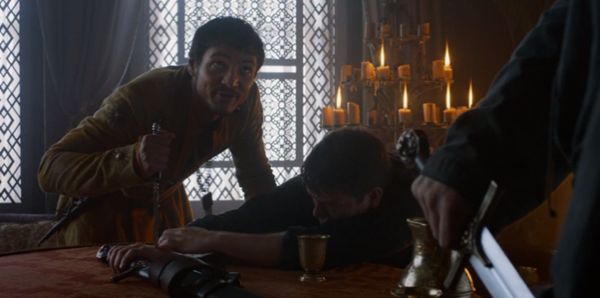
Throughout the series, the show writers often have certain characters sing this song, as a dramatic plot point and indicator of character allegiances. In Season 4, a new character, Oberyn Martell (Pedro Pascal), hears Lannister soldiers singing “The Rains of Castamere” in a brothel, and promptly stabs them. Thus, the song acts as a character device that allows us to understand Martell’s political allegiances: firmly anti-Lannister. By Season 3, the viewers understand “The Rains of Castamere” to be the Lannister House Theme, and therefore the show can quickly telegraph a character’s political allegiance based on how they react to the song.
Song as Storytelling: The Red Wedding
Although leitmotifs of the Lannister House Theme are scattered all throughout Season 2 and 3, the theme is not heard in full until Season 3, Episode 9, in an iconic episode known to audiences as ‘The Red Wedding’. The first three seasons of the show saw House Stark rise in rebellion against the Crown and declare open war against House Lannister.
In one devastating scene, the Lannisters (working through House Frey and House Bolton) infiltrate a Stark family wedding, slaughtering the Starks and their 15,000 men army. This scene is made powerful and iconic by the chilling way it begins, and its skillful use of score. As the Stark family is seated in the dining hall, the band begins to play “The Rains of Castamere”, the song about the Lannisters destroying their enemies. “The Rains of Castamere” is a string-based track, typically performed on the Violin and Cello. It is a slow, steady and rhythmic track, and the prolonged note holds in the D Minor key evoke a sinister but still atmosphere.
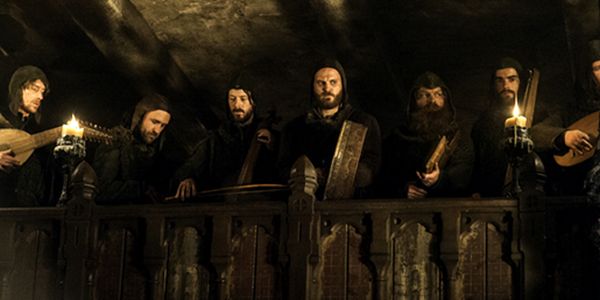
The mother, Catelyn Stark (Michelle Fairley), immediately recognises the theme, and a close-up of the actress’s face details the exact moment she realises something is wrong. However, when Catelyn looks around the room, she sees no immediate threat. So, she sits down and continues her meal, unnerved.
Director David Nutter here uses the score, quietly performed by the Frey band in diegesis, to build a sense of dread, tension and foreboding. By removing the lyrics and playing only the instrumental version of “The Rains of Castamere”, Nutter establishes a fraught atmosphere of confusion, without explicitly telegraphing that the Lannisters/ Freys are about to kill them all.
https://youtu.be/ZnxvUuSzbMI
The slaughter doesn’t begin for several more minutes, however the moment “The Rains of Castamere” begins to play, the audience, and the Starks, realise that something horrifying is about to happen. As the massacre begins, the sound is mostly filled with the diegesis of screaming and stabbing, however the frantic track “The Lannisters Send Their Regards” plays in the background.
“The Lannisters Send Their Regards” track begins with a bang, when the pregnant Talisa (Oona Chaplin), wife to Robb Stark (Richard Madden) is brutally stabbed in the stomach. On this cue, the rapid high-pitched string pulses begin, evoking sonic memories of the shower-stabbing leitmotif in Bernard Hermann’s score for Alfred Hitchc*ck’s Psycho. The quick crescendo of these high-pitched pulses results in a unpleasant cacophonous tone colour, which reflects the chaos and panic of this moment, as the hall turns into a battleground of dead bodies and carnage.
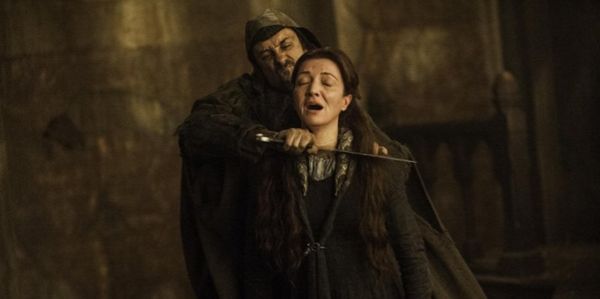
In an interview with the Hollywood Reporter, Djawadi discusses how that he wrote the Lannister Theme so early in the show, because the producers wanted an entire two seasons for the audience to learn the Lannister Theme. Djawadi explains that “by the time we get to season three, it’s a known theme that viewers will identify with the Lannisters — so when you hear it, you will know something is off, and that this melody does not belong at this wedding.” Director David Nutter and Composer Ramin Djawadi invest two season’s worth of audience familiarity with the Lannister Theme’s leitmotif, all to make this crucial scene all the more devastating and unnerving.
The Red Wedding scene is one of the most iconic in the entire series, and therefore the Lannister Theme is one of the most iconic songs of the entire series. The leitmotif melody from “The Rains of Castamere” continued to be used after that episode. The episode ends with “The Lannisters Send Their Regard”, and in the next episode “A Lannister Always Pays His Debts” is played as the Lannisters celebrate their success.
‘Two Swords’: How Ramin Djawadi Combined the Lannister and Stark Themes
In Season 4 Episode 1, the sword of Ned Stark (Sean Bean), the Stark father killed by the Lannisters in Season 1, is destroyed. As Stark’s sword is being melted down by Tywin Lannister (Charles Dance), the Lannister patriarch, the track “Two Swords” plays. In this track fascinating track, Ramin Djawadi combines two different leitmotifs, the House Stark Theme, and the House Lannister Theme, to musically dramatize House Lannister’s defeat of House Stark.
Just as the visual imagery of the Stark sword being destroyed by the Lannisters symbolises Lannister triumph, so too does the invocation of the Lannister theme over the top of the Stark theme. As the series goes on, and more characters meet Djawadi creates more of these hybrid themes which are fascinating to listen to once one understands each of the House Themes.
Light Of The Seven: A Masterclass in Building Tension Through Score
A fascinating scene to contrast with The Red Wedding, and another one of Game of Thrones’ most famous, is the scene where Cersei Lannister (Lena Headey) blows up the Great Sept of Baelor, executing most of her enemies with one single explosion. In Season 6 Episode 10, The Winds of Winter, the High Sparrow (Jonathon Pryce) summons Cersei to trial to answer for her sins, which involve murder, incest with her brother, and committing adultery while married.
Cersei was previously brutally imprisoned by the High Sparrow and holds a deep hatred against him. The finale episode opens on the lead characters dressing for this trial, including Cersei, her son, King Tommen (Dean-Charles Chapman), and the High Sparrow.
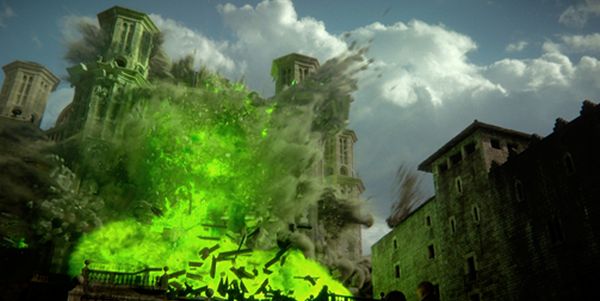
Over the course of a ten-minute-long musical track, “The Light of the Seven”, the audience observes a montage of characters getting dressed, attending the trial and waiting for Cersei and Tommen to arrive. Eventually Lancel Lannister (Eugene Simon), a religious servants from the sept, goes looking for Cersei and discovers that the sept has been loaded with Wildfire (a highly flammable liquid that acts with the power of a large bomb when ignited), just before it explodes, killing everyone inside the sept. Simultaneously, Maester Pycelle (Julian Glover) is stabbed by young children who are doing Cersei’s bidding. Meanwhile, from the Red Keep, Cersei looks down at the carnage, and smiles.
This scene, where a Lannister executes their enemies, seems like an obvious candidate for the Lannister Theme. However, it is for that exact reason that Ramin Djawadi decided to go with something completely different. In an interview on Score: The Podcast, Djawadi explained the decision he made with the producers:
In Season 6, that big piece with Cersei, we actively decided “Let’s not play the Lannister theme”, which would have been obvious for Cersei. And we said, “No let’s have a new piece”. We even decided actively to use piano which at that point had never been used in six seasons of the show. So, we said, the piano itself, it will make people will sit up and go “What’s that sound? We haven’t heard this before. Something’s off, something’s not right”.
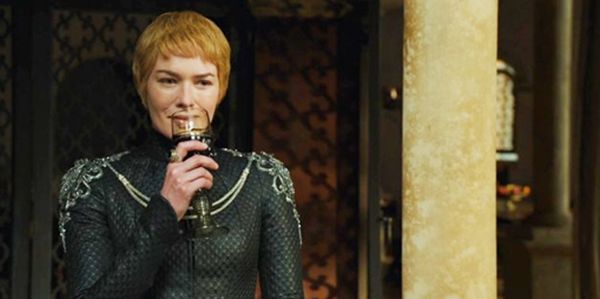
And make audiences sit up it did. The ten-minute piece, “Light of the Seven”, which begins with a soft piano solo before eventually turning into an intense, thumping organ piece with rapid string movement, was unlike anything that Game of Thrones had ever done. It’s worth noting that piano has only been used two times in the entire 8 seasons of Game of Thrones: first, in season 6 when Cersei destroys the Sept, and then recently in the Battle of Winterfell, with the slow, mournful piece “The Night King”.
The slow soft piano opening of “The Light of The Seven” was full of pauses which, coupled with the montage shots of the characters getting dressed, provoked a sense of intrigue at what was going on. The gaps in Djawadi’s score, coupled with the silence of the actors, opens this scene with a sense of stillness and peace, that dramatically juxtaposes the violent action to come. In a Vanity Fair interview, Djawadi describes the intended effects of the intriguing silences: “It raises the question right away, what’s going on here?”
After the initial piano solo, then comes the strings, and then the angelic duet of boy’s voices. Djawadi describes this scene as a track that “starts off very minimal and then it slowly builds”. The young boys singing is both a nod to the scene’s religious setting, and a sonic image of innocence about to be contradicted by Cersei’s vicious child assassins. Djawadi describes the changes in tone colour that occurs when Cersei’s first enemy get stabbed by her child assassins:
…that’s when it switches to the organ and that’s when the choir comes in. That’s really the next step up when you realise, wow, this has all gone wrong right now. And now the piece is really starting to build. More instruments come in and the organ gets busier and the orchestra comes in at the very end.
The ten-minute-long track ends the moment the church explodes. All music ends there and we here only the diegetic sound effects of the church exploding. At the start of the ten minute track, the audience witness a montage, another cinematic technique that Game of Thrones had not yet done before. In Roger Parker’s lecture he describes the film music theory technique known as suture, which the Director Miguel Sapochnik applies here.
Parker describes suture as “having music continue across a prominent cut in the visual narrative served to bind the whole experience together, making viewers less aware of the sudden change and thus less aware of the film world’s essential artificiality”. By connecting the individual shots of Cersei, Tommen and the High Sparrow, with one singular overarching track, Sapochnik unites what could be a several jarring moments into one unifying scene.
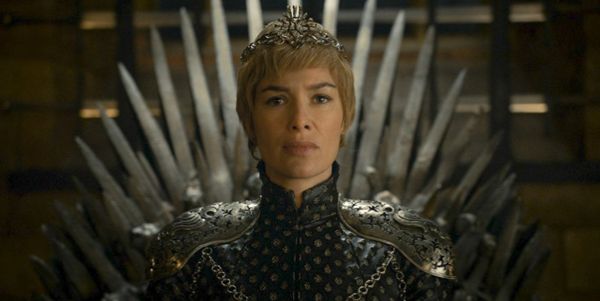
Later that episode, Cersei’s son, King Tommen, shocked at the destruction of the church and his mother’s actions, kills himself. Shortly after, Cersei seizes the throne for herself as the show returns to the Lannister leitmotif, but with a more tragic delivery. As Cersei is coronated as queen, the track “Hear Me Roar” plays. The first section of the piece is a slower version of the foreboding opening of “The Rains of Castamere”, a strong auditory cue of Cersei’s Lannister identity.
This moment is hugely complex, as Cersei receives the power she’s always wanted, at the cost of the lives of the three children she’s always loved. The track is slowed down, and the pitch is lowered, creating a more sombre, funeral-like tone. “Hear Me Roar” concludes by evoking the organ motifs previously heard in “Light of The Seven”.
Where Are We Now? The Scores of Season 8 (Spoiler Warning!)
The show’s much anticipated finale aired only ten days ago, and even if you were one of the many people disappointed by the show’s conclusion, there’s one thing all Game of Thrones fans can celebrate together: the soundtrack. Ramin Djawadi dropped the full season 8 soundtrack recently, and oh boy: it did not disappoint.
Highlights of the first half include the foreboding “Jenny of Oldstones”, the haunting “The Night King”, and the mournful accompaniment to Winterfell’s mass funeral, “Farewell”. The second half of the soundtrack ends the series on a high, with the tense and deeply uneasy “The Bells”, the devastating double hitter of “For Cersei” and “Nothing Else Matters”, and the triumphant montage sequence using “The Last of the Starks” and “A Song of Ice and Fire”.
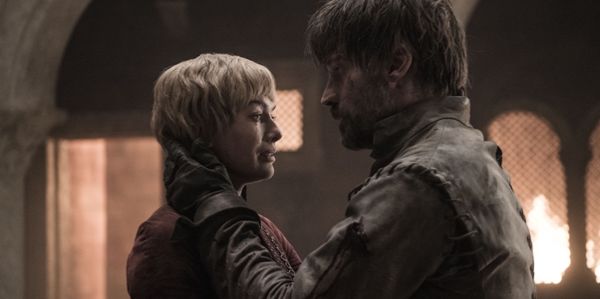
Elements of both key Lannister themes, “The Rains of Castamere” and “Light of the Seven”, appear together in Game of Thrones’ penultimate episode, Season 8 Episode 5 The Bells. In this shocking episode Daenerys Targaryen (Emilia Clarke) destroys King’s Landing, burning the city with her dragon, while “The Last War” plays. As she does this, certain caches of Wildfire are also ignited, and the red flame and black smoke of the city is joined by vivid green flames. While this happens, organ elements from the “Light Of The Seven” leitmotif can be heard, therefore acting as a sonic callback to Cersei’s similarly shocking actions in Season 6.
This episode also contains a version of the Lannister Theme, in its most emotionally compelling use since The Red Wedding. As the city is besieged by dragon-fire, Jaime (Nikolaj Coster-Waldau) runs through the burning city, trying to find his way back to Cersei. When the Red Keep gates shut, Jaime desperately tries to be recognised by Lannister guards, to no avail.
At this moment Director Sapochnik shows us the last remaining Lannisters, cutting from a shot of a frantic Jaime, to a steel-faced Cersei, to a very worried Tyrion. As the Red Keep burns, Cersei and Jaime hide beneath the castle, holding each other in their arms. As Cersei cries, Jaime holds her face and says his last words “Nothing Else Matters. Only Us”, a callback to season 1 when Jaime threatens to start a war with Robert Baratheon (Mark Addy) to be with her. In their final moments together before the castle collapses, Djawadi’s “For Cersei” plays, a slow, sombre use of the “The Rains of Castamere” leitmotif.
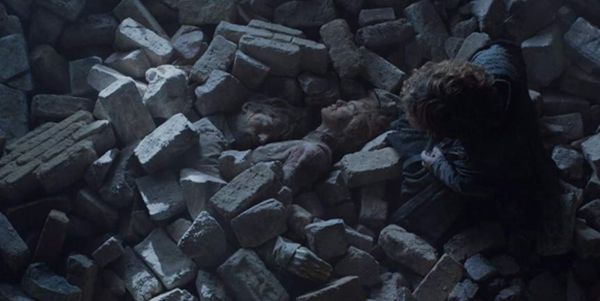
Later, in the opening scene of the finale, Tyrion goes looking for Jaime and Cersei, and discovers their broken bodies entwined under the rubble. The combination of Peter Dinklage’s devastating performance, and Ramin Djawadi’s heartbreaking track “Nothing Else Matters”, makes this an unexpected contender for one of the most moving moments in the season. As Tyrion holds his siblings’ bodies, sobbing, the Lannister House Theme plays for the very last time.
Conclusion
Game of Thrones wouldn’t be Game of Thrones without Ramin Djawadi, who has been producing consistently excellent scores for the past nine years. Although not always obvious to the average viewer, the dramatic impact of Djawadi’s use of leitmotif in House Themes like “The Rains of Castamere”, cannot be overstated.
The many writing flaws of Season 8 aside, this year brought us some of the best music of Game of Thrones’ history. And for that we say, thank you Ramin Djawadi.
Does content like this matter to you?
Become a Member and support film journalism. Unlock access to all of Film Inquiry`s great articles. Join a community of like-minded readers who are passionate about cinema - get access to our private members Network, give back to independent filmmakers, and more.
Jo is 21 years old, studying film and theatre at university in Sydney, Australia. She has been writing about movies since 2015 on her website scribblesofstageandscreen.com and has written for AussieTheatre.com, Blitz UNSW and Film Inquiry. She is currently the sub-editor of UNSW Tharunka Magazine. Her favourite movies include The Intouchables, Oceans 11, Chicago and The Grand Budapest Hotel. She is a proud supporter of Australian film, any movie that passes the Bechdel test, and any movie with Cate Blanchett in it.













